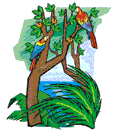Frogs and Toads
A lesson and worksheet on frogs and toads.
Objectives:
• Students will be able to describe the physical characteristics of frogs and toads.
• Students will be able to identify the behavioral characteristics of frogs and toads.
• Students will be able to describe the similarities and differences between frogs and toads.
Suggested Grades:
3rd Grade - 4th Grade - 5th Grade
Print the reading comprehension worksheet passage and questions (see below).
Students should read the passage silently, then answer the questions. Teachers may also use the text as part of a classroom lesson plan.
Lesson Excerpt:
Frogs and toads are both amphibians. Amphibians are animals that spend part of their lives in the water and part on land. Most frogs and toads are born in the water and spend the first part of their lives there. As adults, they spend most of their time on land, but return to the water to mate and lay eggs. The eggs hatch into tadpoles, baby frogs that resemble fish. Tadpoles are herbivores. They eat plants in the water.
When tadpoles grow into adult frogs or toads, they become carnivores, eating mostly insects as well as spiders, worms, small fish and other tiny animals. Some, like tree frogs, never enter the water, while others spend most of their lives in or near it. Both frogs and toads are cold-blooded animals. They usually avoid direct sunlight and are more active at night or on cloudy, rainy days.
Continued...

Lesson Printables:
Print this printable worksheet for this lesson:


